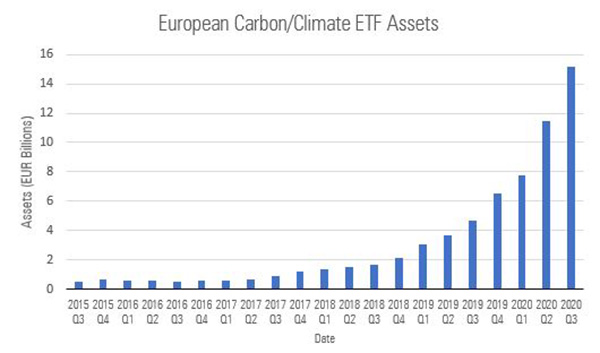
The market for climate exchange-traded funds is expanding fast. Assets in climate-aware ETFs have more than doubled since the beginning of the year alone and now sit at record levels. One in four of all ETF launches in Europe this year has an explicit climate-aware focus.
There are currently 44 climate-aware ETFs listed in Europe and their approaches can differ greatly. Here we cast our eyes over the current crop of ETFs with a climate focus listed on the London Stock Exchange.
HSBC, iShares and Xtrackers all offer a range of broad equity ESG ETFs, with an additional focus on climate.
In November 2019, iShares introduced additional fossil fuel screens to its popular SRI ETF range. The funds now exclude any holding with fossil fuel exposure through extraction and production activities, power generation activities or reserves ownership.
Xtrackers' flagship range of ESG equity ETFs goes further, employing MSCI’s Low Carbon Leader methodology. Beyond the best-in class ESG selection process, this approach excludes the top quintile of holdings based on carbon emissions intensity across sectors. It also excludes the largest owners of reserves per dollar of market capitalisation, representing 50% of the reserves in the parent index.
For its sustainable range, HSBC focuses on outcomes. Rather than excluding large portions of the underlying universe, it reweights holdings based on carbon metrics. This range of ETFs aims to cut both portfolio carbon and fossil fuel reserve intensity by half.
Also employing a reweighting approach is Lyxor, with its Climate Change Equity ETF range. These funds reweight holdings based upon the opportunities and risks associated with the transition to a low carbon economy. Moving beyond simply reducing carbon exposure, this approach has the benefit of being able to overweight those firms with most to gain from the energy transition.
‘Paris Aligned’ ETFs
As the popularity of climate investing grows, so do the accusations of “greenwashing”. To address this, a number of index providers have worked with the European Commission to ensure that their strategies are aligned with the Paris Climate Agreement goal to limit the increase in global average temperatures to below 2°C above pre-industrial levels.
This goal-focused approach and the stamp of approval from such a respected third party will please many investors. For UK fund-buyers, Franklin Templeton has launched ‘Paris Aligned’ S&P 500 and Stoxx Europe 600 ETFs.
Comparing the Options
With so many different approaches it is easy to get overwhelmed. To help, we have grouped climate-aware ETFs into three categories: US, European and Global. By comparing both Morningstar Carbon Risk and Morningstar Carbon Intensity scores we can see how successful each strategy has been in improving its climate risk and emissions profile respectively.
The good news is that all the climate aware ETFs show improvements in both Morningstar Carbon Risk and Morningstar Carbon Intensity scores versus the broader market.
The Xtrackers ETFs perform well in all three markets, cutting Carbon Risk by more than one third and Carbon Intensity by more than half in each case.

iShares’ range also scores well, although sometimes unevenly so. For example, iShares MSCI USA SRI ETF (SUAS) brings the highest improvement to Carbon Intensity scores but the lowest in Carbon Risk.
This highlights why each fund should be evaluated by the metric most appropriate for each investor. For example, an investor targeting improved risk and return metrics would likely concentrate on Carbon Risk, while an investor more concerned with their carbon footprint should place more emphasis on the importance of Carbon Intensity metrics.
Trade-off Between Impact and Tracking

As with other ESG offerings, there is a general trade-off between the strength of the sustainable impact being made and how closely the fund tracks the broader market.
While the iShares and Xtrackers funds can boost their carbon (and ESG) metrics by excluding large portions of the underlying universe, fund performance can be expected to deviate from the broader market, particularly over longer periods.
This approach may suit the most environmentally conscious investors, but others may prefer a more measured approach. Lyxor’s Climate ETFs might provide the lowest improvement in climate metrics of the funds highlighted, but they also promise to track the broader market most tightly. This means they may best suit investors hoping to improve the climate profile of their portfolio, while taking only a minimal bet against the market.

Other Climate Aware ETFs
Those looking to profit from the structural shift towards renewable energy might use the thematic iShares Global Clean Energy ETF (DNRG), which invests in 30 of the largest players in solar and wind power and has been the best performing ETF in Europe year to date. The narrow focus of the fund means that it’s not suitable as a direct replacement for a core holdings, but may fit snuggly with existing ex-energy funds.
There is currently only one single climate-aware fixed income ETF listed on the London Stock Exchange; the Lyxor Green Bond (DR) ETF (CLMU), which tracks the market for green bonds. These are defined as fixed-income securities that back environmental projects.



























